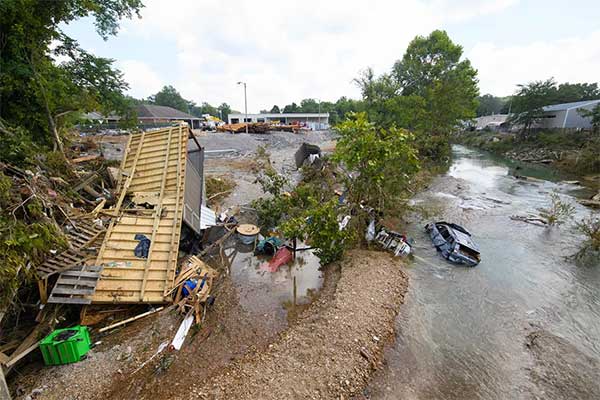Predicting Rainfall With Artificial Intelligence

A research model that uses artificial intelligence to quickly and accurately predict weather forecasts will be tested by the Tennessee Valley Authority to forecast extreme rainfall this summer. The model was created by Puja Das, PhD’27, interdisciplinary engineering, who is supervised by CEE Distinguished Professor Auroop Ganguly.
This article originally appeared on Northeastern Global News. It was published by Cynthia McCormick Hibbert. Main photo: Northeastern researchers are working with the Tennessee Valley Authority on AI forecasts to better predict heavy rains and flash flooding like this deadly 2021 flood. AP Photo/John Amis
With the help of Northeastern, Tennessee Valley Authority experiments with a new forecast model to better predict extreme rainfalls
In collaboration with a Northeastern researcher, the Tennessee Valley Authority this summer plans to test an AI-generated weather forecasting model to see if it will do a better job of predicting extreme rainfalls than traditional models.
With climate change creating more intense precipitation events and flash floods, “you need to have the information right away,” says Puja Das, a PhD candidate in interdisciplinary engineering at Northeastern University’s Sustainability and Data Sciences Laboratory.
She says some existing models take four to six hours to generate forecasts, while others generate hourly predictions that aren’t all that accurate, providing wrong information about the intensity or location of the precipitation.
“Their performance is not up to the mark,” which doesn’t help warn the public about the potential for flash flooding such as a deluge in 2021 that killed 20 individuals in Waverly, Tennessee, Das says.
Her research project explores deep generative models that look at the past 90 minutes of high resolution radar data to generate new forecasts every 10 minutes within a three-hour period.
Das and other Northeastern researchers, including her collaborator August Posch at Northeastern’s Institute for Experiential AI, traveled to Knoxville, Tennessee last year to present the NASA-funded project, called RAIN for Remote-sensing data driven Artificial Intelligence for precipitation-Nowcasting at TVA headquarters.
“They are happy with the results that we are getting,” Das says.
The TVA decided to use the physics-embedded AI-based model to see how it performs during extreme weather events this summer, she says. “Very soon we will have test results from real life, real-time incidents.”
The TVA “needs accurate precipitation forecasts to inform dam operators and river managers,” says Auroop Ganguly, Northeastern distinguished professor of civil and environmental engineering, who is supervising Das’ thesis.
“They’re looking for better forecasts for their operational needs to be able to inform flood emergency and hydropower managers,” he says.
Read full story at Northeastern Global News